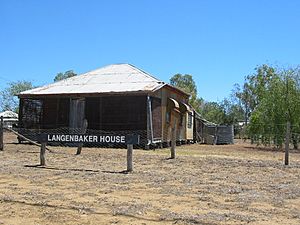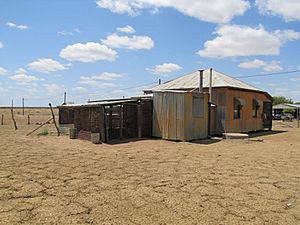Langenbaker House facts for kids
Quick facts for kids Langenbaker House |
|
|---|---|

Langenbaker House, 2003
|
|
| Location | Mitchell Street, Ilfracombe, Longreach Region, Queensland, Australia |
| Design period | 1870s - 1890s (late 19th century) |
| Built | Before 1899 |
| Official name: Langenbaker House | |
| Type | state heritage (built, landscape) |
| Designated | 29 November 2001 |
| Reference no. | 601088 |
| Significant period | 1890s-1930s (fabric) 1890s-1991 (historical) |
| Significant components | fence/wall - perimeter, tank - water, residential accommodation - main house, furniture/fittings, garage, shed - storage, trees/plantings |
| Lua error in Module:Location_map at line 420: attempt to index field 'wikibase' (a nil value). | |
The Langenbaker House is a special old house in Ilfracombe, Australia. It is listed on the Queensland Heritage Register because it is an important part of history. This house is unique because it was built somewhere else and then moved to Ilfracombe in 1899. It shows us what life was like for families in the Australian outback long ago.
Contents
A Home on the Move
The Langenbaker House is a small house made of wood and corrugated iron. Harry Langenbaker, who was a teamster (someone who drove wagons to carry goods), built it in Ilfracombe in 1899. But here is the cool part: he actually brought the house with him! It was built earlier in another place.
The town of Ilfracombe started in 1890. It became an important stop for teamsters. This was because the railway line was built nearby. Teamsters carried goods and supplies to big sheep stations in western Queensland. They used drays (small carts) or wagons pulled by horses or bullocks.
Teamsters were very important. They helped new towns and farms get what they needed. They even used a bright rag tied to a wheel to measure distances! This helped them figure out how much to charge for carrying things. When new railway lines opened, many teamsters started using motor lorries (trucks). Others found work with the railways or at the local wool scour (a place to clean wool).
The Langenbaker Family Story
Harry and Mary Ann Langenbaker moved to Ilfracombe in 1899. They came from a town called Barcaldine. They brought their house with them on their horse-drawn wagon. It was common for teamster families to move their homes. They often followed the railway lines as they were built. The Langenbaker House was put together on Mitchell Street in Ilfracombe around April 1899. It stayed in the family until 1991. That is when Harry and Mary Ann's youngest son, Bernard, passed away.
Harry Langenbaker worked hard as a teamster. His son Bernard remembered: "Dad worked down on the lower Barcoo. Often he would be away for twelve months at a time. While there was work to be had he wouldn't come home. While he was away Mum would often play the piano on Saturday nights at euchre parties and dances at the hall next to the hotel. This way she got a few shillings to battle along."
Harry used horses for his wagons when he came to Ilfracombe. He had about 50 horses! He kept working as a teamster until 1922. After that, he made skewers for the local butcher and greenhide whips.
Mary Ann Langenbaker was very different from Harry. She was graceful and skilled at needlework. Many of her beautiful creations are still in the house today. She was also a talented pianist. She taught piano to many children in Ilfracombe. People often asked her to play at town parties.
Harry and Mary Ann had eleven children! Their children later married into other local families. This created a strong network of friends and relatives in the town.
A House Full of Memories
The Langenbaker House was a central place for the family. Even after their children grew up and married, they often gathered there. Marge Escreet, one of their grandchildren, remembered: "All the Langenbaker girls and their children used to gather for afternoon tea. There was a large pepperina tree at the side of the house. Chairs and stools stayed outside. Afternoon tea was held outside. The children used to ride bikes and play on the big old wooden swing. They would stay there until the shade of the house came over. It was lovely and cool out there. You would get a breeze out there."
Harry built the swing from heavy bush timber and parts of his horse harness. It was right near the back door.
One of their children, Les, became blind around 1921 after a horse riding accident. After this, the family made sure not to change the house much. This helped Les find his way around easily. This is one reason why the house looks so much like it did long ago. It is filled with old photos, interesting objects, and personal items. You can see things like a tennis trophy won by Bernie Langenbaker. There are also old metal tubs, a handmade wheelbarrow, and even early hairdressing tools from the 1930s.
In 1933, a strong windstorm damaged the house. After that, the back verandah was enclosed. The kitchen was also moved to its current spot. The roof was changed from a gabled (pointy) shape to a hipped (sloping on all sides) shape. Around 1942, an air raid shelter was dug near the back of the house.
A special feature of the house is the way the verandah is screened. It uses woven strips of hoop iron. This iron was originally used to tie up wool bales at the wool scour. People in town found it was great for making shaded verandahs. This unique style was once common in Ilfracombe. Now, it can only be seen at the Langenbaker House.
Bernard, the youngest child, was born in the house in 1913. He lived there until he passed away in 1991. After that, the Ilfracombe Shire Council bought the house. They have kept it safe as a tribute to the ordinary people of the outback.
What the House Looks Like
The Langenbaker House is in the middle of Ilfracombe. Like many houses in the town, it was brought from somewhere else. Its light timber frame made it easy to take apart and put back together.
There are four main buildings on the property:
- The main house
- A garage
- A shed
- An outdoor toilet
The Main House
The house sits on low stumps. It has a front verandah, a lounge room, three bedrooms, and a combined kitchen and dining area. There is also a back verandah with a bathroom. A semi-detached rainwater tank is nearby.
The house is made of corrugated iron and timber. It used to have a central hallway with bedrooms and a lounge. The back verandah is now fully enclosed. The original pointy roof was replaced with a hipped roof. Windows have metal awnings to block the sun. The front verandah is enclosed with the special woven hoop iron.
Inside, the house looks much like it did around 1921. Some walls and ceilings are covered with timber panels. Other areas still show the corrugated iron walls and wooden beams. The furniture is simple, and some pieces were even built by Harry himself. The lounge room still has an old Radio-Gram and a television. The house is full of old photos, interesting items, and household tools.
Other Buildings
Near the house, there is a garage. It is now filled with many old items. There is also a shed nearby, also partly filled with old things. An outdoor toilet is located to the east of the house.
At the back of the property, you can see the remains of an old butcher's shop. It was once run by Syd Bailey. The original outdoor toilet, designed for night soil removal, is also still there.
The property has a fence, but the front gate is gone. There are still sheds for vehicles and horses in the yard. Most of the gardens are gone, but a peppercorn tree still stands in the front yard.
Why It's a Heritage Site
The Langenbaker House was added to the Queensland Heritage Register in 2001. This means it is very important to Queensland's history.
It shows us how towns in western Queensland grew. It also shows how people lived and worked in the transport industry long ago. The house is a rare example of a typical worker's home in Ilfracombe. It shows how buildings were designed to fit the climate and available materials. The unique use of woven metal straps on the verandah shows how early settlers were creative with what they had.
The house also tells the story of Harry and Mary Ann Langenbaker. It has stayed almost the same since it was built in Ilfracombe. The house and everything inside it, like personal items and tools, give us a look into the life of a pioneering family. It helps us understand how the town of Ilfracombe was established. The Langenbaker family lived in this house for many years, from 1899 until 1991.


